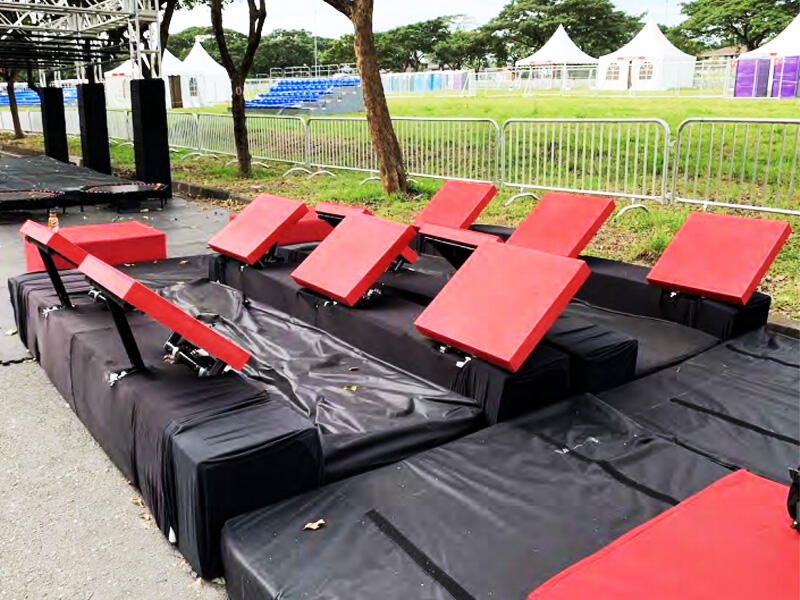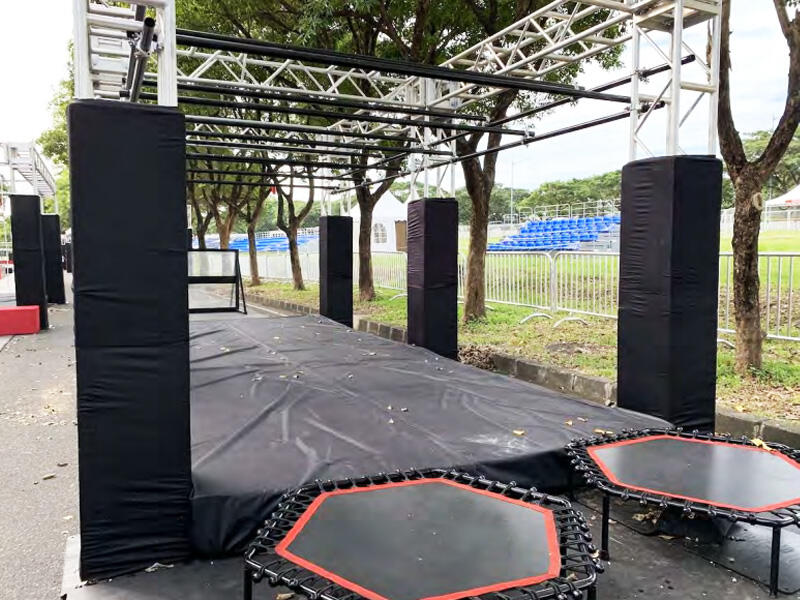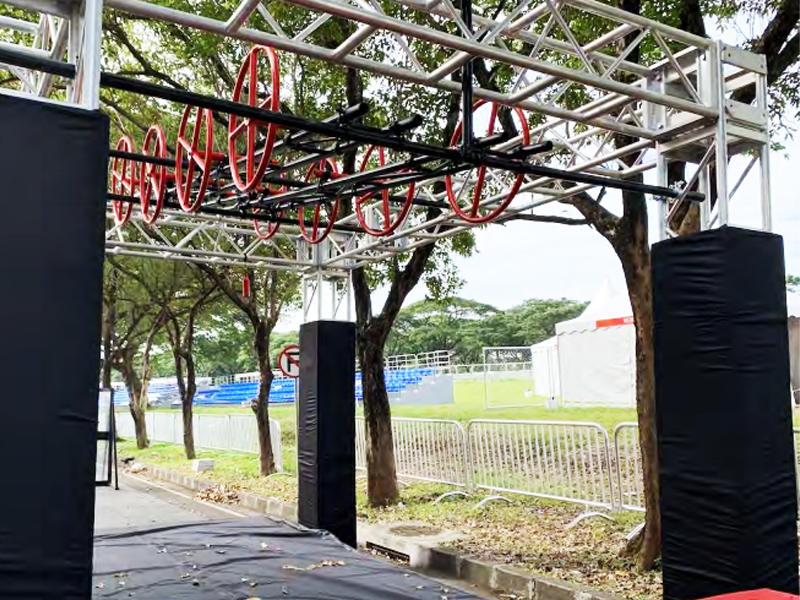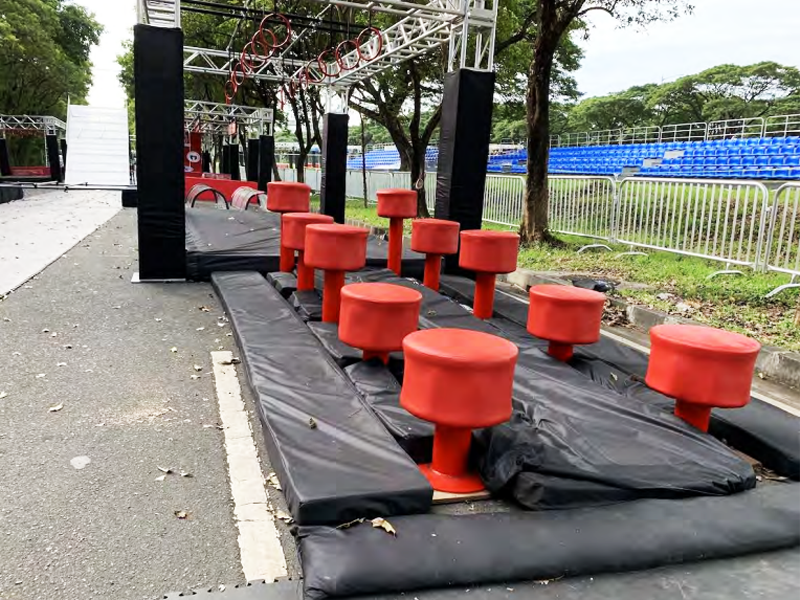Wapi kufikia Maputo ya Kiarubai OCR 100m kwa michezo ya mapito rasmi ya FISO
Mafunzo Mengine Mzuri za Kupunguza Kwa Sababu ya Barua Pepe ya FISO OCR 100m
Viongozi Vya Kupunguza waliothibitishwa na Formula ya Michango
Vipaji vya mafunzo vinahitaji ushahidi wa kutosha ikiwa wanataka kufikia kwa viwango vilivyowekwa na Fédération Internationale de Sports d'Obstacle (FISO). Mchakato wa kushuhudia huchunguza je, vifaa hufuati amri kali kuhusu mambo kama usalama wa mwanariadha, viwango vya uundaji wa njia, na kвалиفيكيشن za wafundi. Vipaji vilivyopewa shahada vinajiri duniani kwa ujumla. Tunawaona Marekani, katika sehemu mbalimbali za Ulaya, na hata Australia. Kama vile OCR Training Grounds hapa Amerika, au European OCR Centre iliyoko Ujerumani. Australia pia ina eneo maarufu kinachoitwa Ninja Warrior Academy ambalo wanariadha hutoka mbali na mbali tu kwa ajili ya mafunzo. Mapepe haya yamefanya uwekezaji mkubwa katika vifaa na miundombinu ambayo inawapa wanariadha uzoefu wa kimsingi wa siku ya mashindano.
Ni mizani ya maeneo ya mafunzo haya ya kipekee ambayo ina changamoto za kujenga ambazo haviwezi kufanya vizuri OCR uzoefu na pia mafunzo ya kusanywa ya mafunzo yanayotembelewa na wafundi wenye uzoefu. Wengi wa wafundi hapa wamek spendia miaka mingi kushindana na kufundisha katika tukio halisi ya OCR, hivyo wanajua kamili kile kinachohitajika kupandaa kwa hizo makurasa ya ngumu. Mizani mwenyewe ina changamoto za aina mbalimbali kuanzia kwa kusukuma kuta za wima hadi kuswima viti mahali pamoja na maji, ikifanya maeneo haya yafaa kama mtu ni mchizi au tayari amejua vizuri kile kinachofanywa. Kila mtu anayethinki kujua FISO alama ya eneo la karibu lazima aangalia vya uwanja hawa vya kifaa vinavyopatikana kwenye mtandao. Mara nyingi wanatoa video za mizani yao na wakati mwingine hata kushirikiana na mafunzo ya wafundi wao.
Vijiji Vya Karibu Na Mapigano Ya OCR
Makanisya ya jumuia ambayo yana vitu vya OCR husaidia wale ambao hufanya mazoezi ya kujitegemea. Wapanda miti hupata vitu kama vile ukuta wa kweli, vibandiko cha panga kwenye paa, na vitu vya kale vya kibandiko cha kobe, hivyo hupata mazoezi ya kusonga ambayo ni muhimu. Lengo kuu ni kujenga mazingira ambayo inaonekana kama ile watakaupata katika mashindano, hivyo wakati wa siku ya mabingwa hawapate vibaya kati ya mazoezi na hali halisi.
Wakati wa OCR wanapata soko la jumla inatafuta jumba la vyumba vya mazoezi, wanahitaji vivutio na watu ambao wanajua kile wanachopitia. Kukaa pamoja na wapendwa wa OCR hawa kwenye eneo hilo linawezesha kudumisha hisia ya juu na kufanya mazoezi iwe na faida. Watu wengi hupata mapendekezo kupitia kikundi cha OCR au barabara za mtandao zenye uhusiano na makimbia ya kipembavu. Kukwenda kwa muda mfupi kwenye jamii hizi mara nyingi huleta jumba la vyumba vya mazoezi ambalo linajua vizuri mahitaji ya mazoezi ya OCR. Maka hawa huwa mafuriko ya dhahabu kwa mtu yeyote anayehitaji kuboresha utendaji wake katika makimbia.
Mipari ya Nje na Msimamo wa Ardhi
Makao ya mafunzo ya nje ambayo inafanana na vikwazo halisi ni ajabu ya kutosha kwa mtu yeyote anayehitaji mazoea ya OCR. Kitu cha kufanya mafaa haya muhimu ni mchanganyiko wa aina za ardhi - fikiria kama vile kusiniwa kwa pembe, sehemu za lami, sehemu za msitu, na mawe yenye usawa. Mwingi huu hufanya wapinzani wataalamu kwa mazingira ambayo yatatokea kwenye siku ya mbio wakati mazingira hutobolea kwa haraka. Isipokuwa mwenza wa viungo, mazingira haya pia yajifunza masomo muhimu. Wapiga mbio wanajifunza jinsi ya kurekebisha mwendo wao wakati wa kupata vikwazo usivyotarajiwa, kudumisha usawa juu ya uso usio sawa, na kushutumia nguvu zao wakati wa vipande vya muda mrefu. Uzoefu huu hutoa matokeo bora katika mazingira ya kimas competition ambapo kutobolea ni jambo la kawaida.
Miondombango maarufu ya pamoja na mafunzo ya OCR ni Griffith Park huko LA na Hampstead Heath kwa upande mwingine wa bonde huko London. Sababu ya kutoa kwa makao haya ni tofauti za maeneo yao ambayo yanaipa watu uwezo wa kupanga miondombango tofauti. Badala ya kutegemea vyoo, wasimamizi wanaweza kutumia miti, milima, na vipengele vingine vya asili ili kujenga mizimbidi yao na njia za kimbia. Aina hii ya mafunzo hainaongeza kitu cha maalum kwenye mazoezi ya kila siku. Kwa matokeo bora, mtu yeyote anayejiamini mafunzo ya OCR atafaa kupangwa mapema kwa siku za mafunzo. Panga miondombango tofauti ambayo itajibiza nguvu na uwezo wa kimsimamizi pamoja. Hivyo, watakuwa tayari kwa hali zote za siku za mabingwa bila kugawa pesa nyingi kwa vifaa vya kushangaza.
Majaribio Pekee ya FISO OCR 100m Kujitupa
FlSO 100m OCR Obstacleâ OF Offset Steps
Sehemu ya Offset Steps kwenye kozi ya FISO 100m inaonesha wadau sana kwa kutathmini kwa usahihi na uharibifu. Washiriki hupaswa kuangalia kila hatua wakati wanapogonga kutoka kwenye point A hadi B kwenye mabati haya ya kipekee. Siri hapa ni kudumisha mizani kwa kushusha kitovu cha uzito wa mwili na kuhakikisha kila haraka ina thamani. Wapinzani wengi hujaribu kufika mbele na haraka na kuhamisha uzito wao kati ya hatua kwa haraka, na hii mara nyingi huishia vyema ambapo mtu amepoteza mizani na kugongwa kwenye mabati. Njia bora? Tumia muda kwenye kila hatua, zokoo na kumbuka sheria zinazosema kwa ufasaha kwamba haujafagia uso wa ardhi au mabawa ya chuma kwenye upande wakati wa kugonga.
FlSO 100m OCR Makamu -OF Monkey Bars
Mandhari ya panya ni moja ya makabila ambayo hutafuti mno nguvu ya juu ya mwili. Washindani hufaa kutegemea kila kigezo cha mikono yao wakati wote wakati wa mchoro huku wakihakikisha kuwa mabegani yao yamechini ya shikamu zao kila wakati. Kujitayarisha kwa mhimili huu unahusisha kufanya mazoezi ya nguvu ya mkono kama vile kuvaa kwenye bar kupaswali na kufanya upesi wa juu zaidi ya mara moja. Mazoezi haya yana jumla ya uwezo na mfumo bora wa kiswingu kati ya mandhari. Watu wengi hujiona kuwa kuchunguza wengine wakipanya mandhari ya panya kwanza yawaonea mambo gani yanafaa. Kujiona jinsi wanashindana wazima wanavyoweza kuweka mikono yao na kudhibiti mawendo yao yampa wapya maelezo ya kuhakikisha wapasuke usikuwa na kupoteza muda.
FlSO 100m OCR Makamu -OF-4-Wheel Rig
Vipimo vinne vya gurudumu vinaponga kwa kweli uwezo wa mwanariadha, hasa wakati mwanadamu hamelea kwa mwelekeo fulani. Wanasiasa hawapaswi kutumia chumba cha ardhi wakati wamelea kando ya nyendo, maana hayana budi kugusa chochote ila vatu vinne vya gurudumu. Watu wengi huanza kufanya mazoezi kwenye toleo rahisi kabla ya kuingia kwenye toleo kamilifu. Mifano ya mazoezi ya kwanza ni mazoezi ya kusogelea kulia na kushoto na mazoezi ya ustahitimaji wa mikono kwa sababu sehemu hizo zinapongwa sana wakati wa mabingwa. Ufuatano wa mwili pia unafaa sana kwa sababu wanasiasa wa kwanza wengi hupoteza udhibiti kwa sababu wamepoteza kufanya mizizi yao iwe imewaunganishwa kwa shughuli zote. Kuhifadhi mabadiliko ya ghadhabu kati ya sehemu husaidia kuhifadhi nishati na kuzuia mzigo wa mali mbaya kwenye viungo.
FlSO 100m OCR Obstacleâ OF Island Steps
Mapambo ya Kisi hivi karibuni inawajibisha mabunifu kushughulikia na mabebete ya aina mbalimbali, ambayo inahitaji usawa na uhakika sana. Wakilishi lazima aendelee kwenye mapambo haya bila kuondoa miguu chini ya ardhi, hivyo kazi ya usawa huwa muhimu kabisa kwa mtu yeyote anayetarajia kushughulikia sehemu hii ya mlima. Masaa ya mafunzo mara nyingi huwajibisha vitu kama kusimama kwenye mguu mmoja wakati wa kuelekea mbele au kufanya harakati haraka za kusonga kulia na kushoto, zote zinazotengenezwa ili kujenga ustabishaji bora. Aina hizi za mazoezi huwafanya mwili ujifunze kujibu haraka wakati mambo yahamia, kama vile mambo yanavyopokea wakati wa matukio halisi ya OCR ambapo mazingira hutandaza mara kwa mara kutoka milima ya mawe hadi vichaka vya thamani.
FlSO 100m OCR Obstacleâ OF Rings Rig
Vipimo vya Rings Rig si ya kufunza kwa mtu yeyote anayetarajia kushinda mbarazi ya kipimo. Hakika huvutia nguvu zako za kushikilia na za midri kote. Wakati wa kushambuliana na hili kitu, walezi lazima wachanige kati ya kila kipimo cha viringo wakati wengine watakapo hupendi kuwa chini ya kiwango cha shingo. Watu wengi ambao wanalazimika kwa ajili ya aina hii ya jambo huchuma wiki kadhaa ili kujenga uwezo wao wa midri na kufanya mazoezi ya nguvu ya kushikilia kama vile kuchanua vijicho wakati wameinuka kwenye bar ya kuvutia au tu kukaa kwenye bar hizi. Walezi wa kawaida wa OCR hawasimishia mtu yeyote anayetaka kusikiliza kwamba kupata ritmu nzuri ina umuhimu mkubwa kuliko kujaribu kuvutia nguvu kupitia haraka. Wale ambao huchukia wakati wao na kusogelea kwa makusudi hupita Rings Rig bila kufallisha au kucheka nguvu muhimu.
Mbinu ya Usimamizi kwa Ajili ya Kufanikiwa katika Saba ya 100m ya OCR
Kuboresha Nguvu ya Kupunguza kwa Matukio ya Kupendekeza
Ukali wa nguvu una jukumu muhimu katika miongo ya kipawa ambapo waigizaji hulukiwa na changamoto za kupumzika kama vile vijiti vya kobe na vijiti vya usawa. Waigizaji ambao wanataka kuboresha ukali wao wanapaswa kupanda mazoezi fulani katika mzunguko wao. Kupumzika kwa matovu na kuchukia kwa mkoba hufanya kazi nzuri kwa ajili ya misuli ya vidole, maendeleo ya mabega, na ustabiliti wa kiuno ambayo ni vipengele muhimu wakati wa kudumisha ukali wakati wa mazoezi marefu. Watari wa kawaida hupendekeza kufanya mazoezi haya takribani mara tatu kwa wiki pamoja na kuteketeza mawazo ya msingi ya uongezaji wa nguvu. Kwa kuanzia kwa kazi na kuzidisha kwa kasi au muda mrefu wa kudumu hujenga nguvu ya kugawia inayohitajika ili kupata miongo ya juu bila kushindwa katikati ya jaribio.
Masomo ya Footwork kwa Mipangilio ya Ujinga
Makusudi ya mizigo hutoa tofauti yote wakati wa kukabiliana na changamoto za OCR ambapo utakatifu na usahihi huchukua nafasi. Kuongeza mapumziko ya mafundi na kazi za pindo katika masaa ya mafanikio ya kawaida hupakua kasi ya mizigo na ushirikiano wa mikono na macho. Mazoezi haya huimita harakati za haraka na za usahihi zinazohitajika ili kupita kwenye vifupu bila kuchukua muda. Wakati wa kuendelea kufanya mazoezi ya ushirikiano wa mizigo kila siku, walezi huanza kujiona maendeleo katika utendaji wao wa mbio. Kupigwa hupungua katika sehemu za nyuma za mteremko, na walezi hupata kasi pale ambapo usahihi ni muhimu zaidi katika nyanja. Walezi wa OCR wengi watawambia kila anayekwenda kuuliza kwamba makusudi ya mizigo si tu muungano bali ni muhimu sana ili kupita sehemu teknical za mbio kwa usalama na kasi.
Usimamizi wa Ufafanuzi kwa Magombani pa Jaribio la Pili
Kupita kwa njia ya makabila mengi katika tukio la OCR hupendelea sana kwenye usimamizi mzuri wa mwenendo. Ili kujengako hili, washindaji wanahitaji kufanya kazi kwenye afya ya moyo na nguvu za misuli. Kufanya mazoezi ya muda fulani inaonyesha mwenendo na inaandaa mwili kurejeshwa tena baada ya kupanda ukuta au kusukuma chini ya waya yenye mistari. Mazoezi ya umbali pia ni mazuri kwa sababu yanashughulikia misuli mingi kwa wakati mmoja, ambayo inajengesha nguvu zinazochukua muda mrefu zisipokuwa na nguvu. Pamoja na mazoezi haya, usimamizi wa moyo na damu unapaswa kuwekwa katikati ya mpango wote wa mazoezi kwa sababu wakati moyo ni mweza, wasimamizi wanaweza kuendelea kwa nguvu hata mwisho bila kuchafuka kabla ya kufikia nusu ya mbio.
Kuandaa kwa FISO OCR Championships
Kuelewa Mipangizo ya Kupendekeza Machozi
Kuingia katika FISO OCR Championships inamaanisha kupiga vituo fulani vinavyotolewa na Fédération Internationale de Sports d'Obstacles (FISO). Sheria hizi huchukua nafasi ya aina ya kipepeo cha uvumilivu kwa walezi kote ulimwenguni, ikimiliki ufanisi wa hali sawa na kuthibitisha ubora kwa ujumla. Walezi waliojitahidi kuhakikia kufaulu wanahitaji kufahamana na mhimili wa sheria za FISO. Ndani yake kuna maelezo mengi kuhusu yale yanayohitajika ili kufanikiwa katika makundi tofauti ya mbio kama vile makundi ya kigeu, ya para, na ya umri. Walezi wenye uchawia wanajua kwamba hawawezi kufanya kila kitu kwa haraka au kwa njia ya kipenzi bali wanahitaji kuunda mipango na mbinu za mazoezi ambazo zitafikia viwango hivyo hata kama wanataka kushinda nafasi katika tukio kubwa.
Kusimamia Hali za Siku ya Machache
Kuendelea na mazingira halisi ya mbio wakati wa mazoezi yaweza kufanya tofauti kubwa wakati wa tukio kubwa. Kuongeza mazoezi ya kati na mazingira ya mbio ya kufanana na yale ya tukio kwenye mazoezi ya kila siku inaonyesha mwanamke waliohusika kwenye mazoezi hali ya shinikizo na nguvu zinazopatikana wakati wa mashindano. Wanamazingira ambao wanafanya mazoezi ya uandamano huu hawajali kujenga mbinu bora za mizani na kujisikia vizuri wakati wa matokeo ya mapema. Hali ya mwingine muhimu ni kufanya mazoezi na vitu sawa sawa vya kuvaa na vya kubeba siku ya mbio - viatu vilivyotengenezwa, nguo zinazofaa hali ya hewa, na vitu vilivyotajwa kwa kunywa. Hili kinachangia kumbukumbu ya misuli na uhakika wa matokeo ambayo inaathiri matokeo ya kuanzia.






